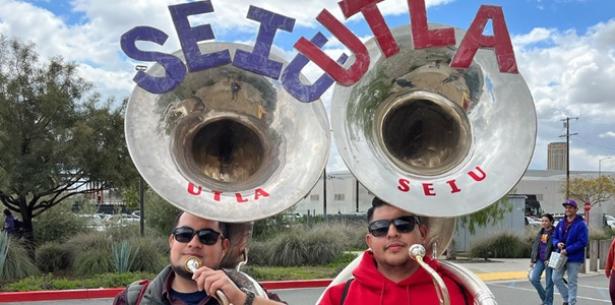When Los Angeles educators joined school support staff on the picket lines last month, our solidarity strike helped them clinch a contract with a 30 percent raise.
Riding that wave, yesterday educators reached a tentative agreement of our own, with a 21 percent raise, smaller classes, and improved staffing.
Superintendent Alberto Carvalho had scoffed in February when support staff voted by 96 percent to authorize a strike. On Twitter he belittled the threat as empty theatrics. “1, 2, 3…Circus,” he wrote, “a predictable performance with a known outcome, desiring of nothing more than an applause, a coin, and a promise of a next show.”
But fast-forward one month, and the joke was on him, as 45,000 people filled downtown’s Grand Park for a high-energy rally where SEIU Local 99 announced a three-day strike and United Teachers Los Angeles announced it would honor the picket lines. There were more than a few signs showing Carvalho dressed as a clown.
News traveled fast after the joint rally. The district’s two largest unions, together comprising 65,000 workers, would stop working and grind the education system to a halt.
ABYSMAL PAY
The 30,000 teachers’ assistants, bus drivers, custodians, cafeteria workers, and other support staff who make up SEIU Local 99 had been working under an expired contract since 2020. Members were making an average of $25,000 a year in one of the nation’s most expensive cities.
Many were juggling multiple jobs. According to a survey by the union, about one-third had experienced or faced the threat of homelessness while working for the school district; one-quarter reported not having enough food to eat.
The union was demanding a 30 percent raise, along with overdue improvements to benefits and hours guarantees. After all, the district had $5 billion in reserves. This contract campaign and the strike authorization vote were a break from Local 99’s pattern, after years of a more conciliatory approach.
Meanwhile we in UTLA were fighting our own heated battle with the district; our contract expired last year. Our Beyond Recovery Platform was a comprehensive vision, drafted with input from all 35,000 members, for improving Los Angeles’s historically under-resourced school system.
Among our proposals were a 20 percent wage increase over two years, class-size reductions in every grade at every school, and “common good” demands like a plan to use vacant properties held by the district to create affordable housing for students and their families.
LENDING A HAND
When the school year began in August, so did UTLA’s contract campaign. Members knew we would have to get strike-ready, and we tapped into the muscle memory from our massive 2019 strike, holding informational pickets before school, red T-shirt Tuesdays and “sticker-up” days, and parent meetings.
UTLA educators had a well of experience to lend our co-workers in SEIU, many of whom had very little connection with their union. Still, many UTLA members had never before been asked to withhold their labor for another union. Would they do it?
It was up to chapter leaders—the elected union representatives at each school site—to convince our co-workers. At meetings held all over the city and in one-on-one conversations in hallways, chapter leaders argued that supporting Local 99 was the morally right thing to do. No worker should be making poverty wages. Plus, the high turnover and support staff vacancies often put more burden on teachers’ shoulders.
Moreover, chapter leaders argued, strong participation in a solidarity strike would strengthen our contract fight too—showing the district our strength and unity.
These conversations worked. When the strike began March 21, teachers showed up to picket lines all over the city; UTLA reports that 95 percent of its members struck in solidarity. (Carvalho closed the schools to students, but left the option for workers to cross picket lines and go to work. Not many did.)
DONUTS AND TAMALES
The morning pickets and afternoon rallies were lively and militant, even in the pouring rain. Students, parents, and community members came bearing donuts and tamales; every neighborhood in Los Angeles was blanketed in UTLA red and SEIU purple.
Now the clown theme had spread all over the city, and you couldn’t go anywhere without seeing signs plastered with Carvalho dressed as a clown. He really shouldn’t have posted that tweet.
Strikers got creative—traveling in delegations to busy intersections, even getting together with those from neighboring schools to plan banner drops. Media coverage highlighted the abysmal pay of support staff, large funding surpluses, and the absurdly high pay of the superintendent, $440,000 per year; Carvalho negotiated a 26 percent salary increase when he accepted the job.
The schools were empty, and the public took the side of the strikers. The strike forced the district into action. Bargaining recommenced, and this time Los Angeles Mayor Karen Bass got involved.
Workers returned to school as planned on March 24. Late that afternoon, Local 99 announced a tentative agreement that would bring members’ average salary up to $33,000, along with improvements to hours and benefits.
ROUND TWO
After the strike, educators returned to the table. But the district knew that if we had to, we would strike again—and Local 99 members were primed to return the favor.
Besides the raise and a reduction of two students in every class at every school over the next three years, our tentative agreement increases staffing of counselors, psychologists, and social workers, and adds more support for special education.
The district also agreed to electrify more school buses and install solar panels, dedicate funds to supporting Black students, and filter the lead out of the water in school drinking fountains—though it stopped short of committing to our boldest demands on housing.
UTLA’s solidarity strike with Local 99 was not only a first for many union members—it’s also uncommon in the labor movement. But as Los Angeles educators and support staff made clear, solidarity gets the goods.


Spread the word